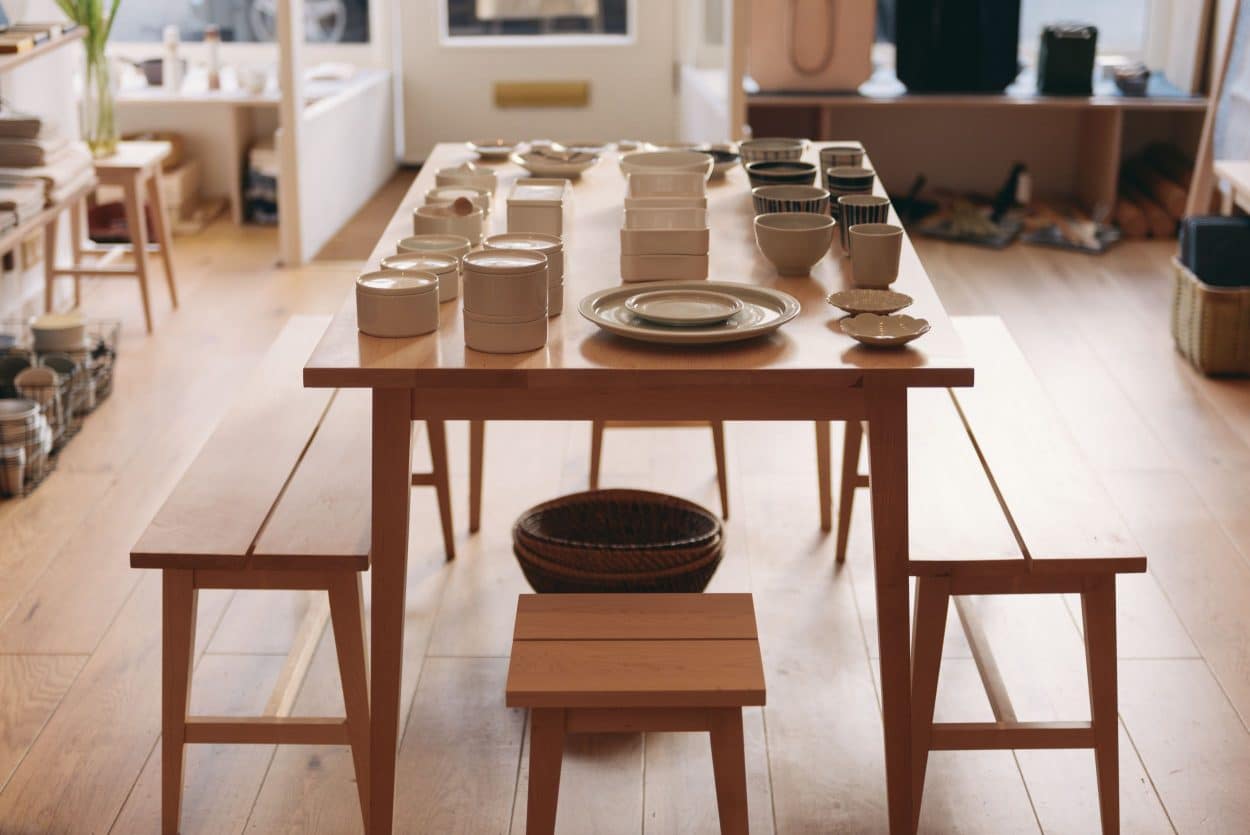International design boutiques are forging relationships with native Japanese makers in order to support Japanese values or wabi-sabi. How do these international boutiques honor and promote the quality found in Japanese designs, representing the imperfections of life and reinforcing the spiritual connection with nature?
A Shopping Trip to Japan
A quaint boutique off Kensington Park road in London, between Ladbroke and Stanley Gardens, brings select designs from Japan and Taiwan to local and international customers.
Chris Yoshiro Green and Sharon Hung co-founded the select shop Native & Co in 2014. Hung, who is Taiwanese, and Green, who is Japanese-British, are culturally linked to the products they offer.
Green and Hung make several trips to Japan during the year to select their stock. They know the Osaka region is famous for knife making and the Tottori region is historically known for its hand-made paper. It’s important to know where to find what (materials) and who (designers).

The Osaka region is famous for knife making and the Tottori region is historically known for its hand-made paper.
On Native & Co’s line of products, the Japanese wooden bath bowl, Japanese Hinoki bath bowl with handle and Japanese Hinoki bath stool are made from Japanese Hinoki cypress trees.
The copper-ringed wooden bath bowl is traditionally seen in hot springs all over Japan. Hinoki wood is naturally mold-resistant and has a lemon scent, making it perfect for the bathroom.
Their porcelain teacup, porcelain plate and porcelain bowl are crafted in the city Arita-cho, the birthplace of Japanese porcelain, using 400-year-old techniques. Some of their newest porcelain plate products come from the collaboration between designer Masanori Oji, founder of design firm Oji & Design, and the 350-year-old Touetsugama kiln. The plates are made from Amakusa porcelain stone, mined on the islands off the coast of Kyushu.
While Green cannot disclose more detailed information about the designers, he describes his most recent visit to Japan last November:
“Some of these workshops are actually family-run. Some of them are almost inside residential areas. I visited some of the wood workshops that we buy from; one of them is a workshop next to his father’s house. Another one is not even a workshop, it is literally a house. I was surprised just how small and quaint they are.”
A Wabi-sabi Love Affair
“If you asked anyone in Japan, they would say wabi-sabi is something that should be felt rather than explained,” Reiko Kaneko, founder of the online Japanese design store Reiko Kaneko, told ArchiExpo e-Magazine.
“It is about finding beauty in irregular and imperfect things. You might find a crack on a bowl very beautiful; you appreciate the natural forces. Especially with firing and glaze work, it gives the opportunity for the natural forces to create those patterns. It is finished with this sadness and understanding that beauty is a fleeting moment that will pass… and that your time on Earth is very short.”
Kaneko’s Bizen Ceramics line exemplifies the wabi-sabi philosophy. Each piece is created by the Ichiyougama father-and-son team, who throws pottery for half the year in a traditional Japanese climbing kiln, or by a local artist potter Toshihide Oae.
Making their products by hand puts these practically anonymous makers “at odds with the public’s mechanized view of manufacturing.” Bizen ceramics are unglazed and wood-fired from the local Inbe clay in Bizen (one of Japan’s ancient pottery towns, located in the Okayama Prefecture).
Kaneko grew up in Japan and thus around the philosophy of wabi-sabi. She implements this into her store’s motto, using the Japanese words monozukuri-no-nakama: fellow of manufacturing. The camaraderie between small manufacturers, makers and retailers outside Japan bolsters the spread of Japanese design to the global market.
A true monozukuri-no-nakama, Kaneko collaborated with the prestigious Japanese company Shotoku Glass to create hand-blown beer glasses for the U.K. market.
“Japan has kept the idea of beauty and impermanence alive, in parallel to the seemingly contradictory consumerist values. I think it is down to everyone on a global level to reflect these ideas and philosophies,” Kaneko told ArchiExpo e-Magazine.

Glazed vase by Reiko Kaneko designs, described by Kaneko as “Japanese in feel, inspired by reactive stonewares of Japan”
A Major Chain and the Two-way Tug
The global market can pose great financial risks for smaller interior design shops, whose modest budget mixes with a low customer base. Major Japanese design chain MUJI and its 700 stores across North America, Asia and Europe could then seem frightening for small boutiques. However, Green explained to ArchiExpo e-Magazine:
“For us, it’s a two-way street. The MUJI brand is very good at opening up the market. They can basically introduce Japanese design, aesthetic and values in a new area through their retail source because they’re such a big brand.”
MUJI recently expanded its design line to the architectural territory. In 2014, the Vertical House, a three-story prefab home without interior walls or doors, became available to the Tokyo market. In addition, at Tokyo Design Week 2015 MUJI revealed three mini-huts.
A different designer created each hut with a different material; Konstantin Grcic used aluminum; Jasper Morrison, cork; and Naoto Fukasawa used wood. However, the Vertical House and mini-huts have not yet made it to the foreign market.
Values like wabi-sabi and maintaining a spiritual connection with nature are hard to find in the MUJI brand; but, as Japanese design continues to expand, MUJI needs small boutiques and small boutiques need MUJI.












